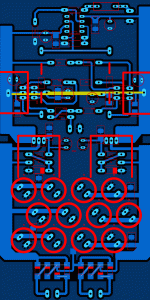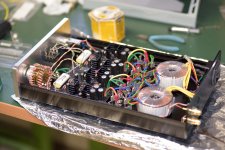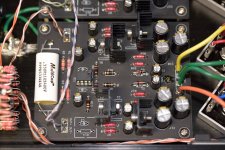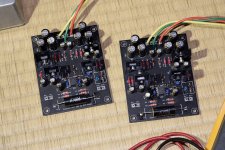Richard, could i use the B2 pad and the -out pad on the 14s1 boards to fit a zobel filter?
like this:

Sure, the capacitor and resistor are in series so the order doesn't matter, and it can go between the OUT+ signal at any point back to the nominal output return, (OUT-, COM).
I remember I strung mine between the pins of the headphone jack at one point.
note: revision 2.0 boards have pads for the optional Zobel filter.
Single Sided board
I used Sprint Layout 6.0 to layout a single sided board. I made a few changes. On board rectifiers are surface mount round barrel type. I think MELF? Anyway, I doubled initial smoothing caps and added a few ceramic caps.
I left out the zobel.
I tried to do it without jumpers but I have two. Otherwise I couldnt find a way to keep ground from being interrupted.
I use large oval pads because they are easier to solder and I always make smt pads larger than they should be for easy soldering.
R5 and R6 are extra long almost like jumpers to reach from the top of the board to the bottom of the 4 transistors.
An MKP4 might not fit by about 2.5mm. I put the .lay file in my post so you can fit in a larger cap if you like.
Also the whole thing had to fit to 3" by 6" to fit my copper clad boards so things look pretty cramped in some areas but I'm looking forward to building it. Dont assume that this works instantly. If you want to use my file then please double check it against the schematic. I might build it this week if I find all the parts. Not sure if I have all the BD140/BD139. I think just 4 of each. So I'll have to order before I will know if this thing works great or not.
The yellow lines are jumpers from the rails. This was just for me to listen to this headamp so perfection is not included on this layout. Its free though 🙂
I'd like to get this working and then try it with a simple BF862 pre vs the opamp. Of course you know I love LDRs so I need to try it with LDRs at some point also.
I used Sprint Layout 6.0 to layout a single sided board. I made a few changes. On board rectifiers are surface mount round barrel type. I think MELF? Anyway, I doubled initial smoothing caps and added a few ceramic caps.
I left out the zobel.
I tried to do it without jumpers but I have two. Otherwise I couldnt find a way to keep ground from being interrupted.
I use large oval pads because they are easier to solder and I always make smt pads larger than they should be for easy soldering.
R5 and R6 are extra long almost like jumpers to reach from the top of the board to the bottom of the 4 transistors.
An MKP4 might not fit by about 2.5mm. I put the .lay file in my post so you can fit in a larger cap if you like.
Also the whole thing had to fit to 3" by 6" to fit my copper clad boards so things look pretty cramped in some areas but I'm looking forward to building it. Dont assume that this works instantly. If you want to use my file then please double check it against the schematic. I might build it this week if I find all the parts. Not sure if I have all the BD140/BD139. I think just 4 of each. So I'll have to order before I will know if this thing works great or not.
The yellow lines are jumpers from the rails. This was just for me to listen to this headamp so perfection is not included on this layout. Its free though 🙂
I'd like to get this working and then try it with a simple BF862 pre vs the opamp. Of course you know I love LDRs so I need to try it with LDRs at some point also.
Attachments
Last edited:
As you've found, a single-sided board necessitates a jumper or two.
By the way, the capacitor banks of 3x1000 uF and 3x100 uF shown on the schematic are not set in stone. It's because I keep a stock of these values common to all my projects, so if I want 3300 uF, for example, I'll just use three 1000 uF in parallel. If I want 2200 uF, I'll use two 1000 uF. Feel free to change the arrangement as you like, a single 3300 uF (or a bit more, or less) will be fine for the filter capacitance before the regulator.
Richard
By the way, the capacitor banks of 3x1000 uF and 3x100 uF shown on the schematic are not set in stone. It's because I keep a stock of these values common to all my projects, so if I want 3300 uF, for example, I'll just use three 1000 uF in parallel. If I want 2200 uF, I'll use two 1000 uF. Feel free to change the arrangement as you like, a single 3300 uF (or a bit more, or less) will be fine for the filter capacitance before the regulator.
Richard
Replaced my first set of 2.0f boards with a new set. This time, I left out the Zobel filter and ceramic bypass caps. C1 reduced from 0.47 to 0.33 uF (Multicap PPFXS). Resistors are PRP metal film, Takman carbon film, and Kayama carbon comp. IC1 is OPA134. Gain is set at 27 dB with R4=22k.
Still breaking in, but it sounds nice. A tad dry, faster than I remember, very nimble actually. I don't think there is any disadvantage to leaving out the bypass caps, none that I can hear at present but I'll put them in later to double check.
Photo note: Nikon D600, Tamrom SP 90mm F2.8 macro 272E
Still breaking in, but it sounds nice. A tad dry, faster than I remember, very nimble actually. I don't think there is any disadvantage to leaving out the bypass caps, none that I can hear at present but I'll put them in later to double check.
Photo note: Nikon D600, Tamrom SP 90mm F2.8 macro 272E
Attachments
Last edited:
goodbye buzz hello silence 🙂
finally got rid of those nasty nasty RS toroids and installed a custom built Toroidy 300-4x12 and it's completely silent.
Have you got any pictures?
just charging the camera battery.
it might be me but i could swear that the noise floor has dropped and everything is sounding a bit smoother. if i had one comment i would say that it has lost a very small amount of soundstage to which i actually like as its brought everything a tiny bit more to the middle of my head. but it could be a placebo.
it might be me but i could swear that the noise floor has dropped and everything is sounding a bit smoother. if i had one comment i would say that it has lost a very small amount of soundstage to which i actually like as its brought everything a tiny bit more to the middle of my head. but it could be a placebo.
front of cases

Amp internals

power supply internals

ignore all the squintness i'm crap at taking pics everything is straight.

Amp internals

power supply internals

ignore all the squintness i'm crap at taking pics everything is straight.
Richard. i was just reading threw the older threads and wondered if you ever found out about the motherboard pin headers you were after as i know what they are.
Oh, the jumper pins? I never tracked them down, but sidestepped the issue by removing the feedback loop selector switch from the rev. 2.0 boards.
Saw various pin headers in Mouser, but never figured out which one is the right/best/standard part.
Saw various pin headers in Mouser, but never figured out which one is the right/best/standard part.
for future reference in case anyone needs them.
The Series is M20 Mouser full series HERE
Pin Strips Mouser# 855-M20-9994045 (45pin)(the pin number is dictated by the last 2 digits)
Housing Crimps Mouser# 855-M20-1180042
Housings Mouser# 855-M20-1060300 (3pin)(the pin number is dictated by the last 3 digits)
The Series is M20 Mouser full series HERE
Pin Strips Mouser# 855-M20-9994045 (45pin)(the pin number is dictated by the last 2 digits)
Housing Crimps Mouser# 855-M20-1180042
Housings Mouser# 855-M20-1060300 (3pin)(the pin number is dictated by the last 3 digits)
Thank you.
Love the pink/purple knobs btw, very unique. Meant to mention that earlier...
Test notes:
As planned, I tried adding back the ceramic capacitors I left out of my new set of boards. Did it in steps, as follows:
1. "nude" (no bypass caps, no zobel). Lively, but some roughness or hash obscured the fine details of orchestral works.
2. add Zobel. Surprisingly large effect. Less air/fizz, more weight, general improvement in definition.
3. add Zobel and ceramic bypass caps next to IC only. Maybe more of the same improvement in definition, maybe not. Near or below my detection threshold.
4. Zobel, and add back all the caps. Not a huge difference that I can hear, but any sense of RFI-like hash or haze that was definitely there in the "nude" version has gone. It's smooth, deep, and resolving.
Based on this test, I recommend building the rev. 2.0 boards as listed, with the Zobel and bypass caps in.
Love the pink/purple knobs btw, very unique. Meant to mention that earlier...
Test notes:
As planned, I tried adding back the ceramic capacitors I left out of my new set of boards. Did it in steps, as follows:
1. "nude" (no bypass caps, no zobel). Lively, but some roughness or hash obscured the fine details of orchestral works.
2. add Zobel. Surprisingly large effect. Less air/fizz, more weight, general improvement in definition.
3. add Zobel and ceramic bypass caps next to IC only. Maybe more of the same improvement in definition, maybe not. Near or below my detection threshold.
4. Zobel, and add back all the caps. Not a huge difference that I can hear, but any sense of RFI-like hash or haze that was definitely there in the "nude" version has gone. It's smooth, deep, and resolving.
Based on this test, I recommend building the rev. 2.0 boards as listed, with the Zobel and bypass caps in.
Richard, how good is your mains?
i usually leave an LED lamp on next to the amp but last night i turned it off and my lord what a difference. all the hash in the top end disappeared, i also used to get a very very faint buzz when the volume was up full (no music) and when i turned the lamp off it was gone and the background is completely silent.
i usually leave an LED lamp on next to the amp but last night i turned it off and my lord what a difference. all the hash in the top end disappeared, i also used to get a very very faint buzz when the volume was up full (no music) and when i turned the lamp off it was gone and the background is completely silent.
I have the same problem with the computer monitor, which is an old LCD with a cheap external power brick. Turned on there was some noise interference in the Sapphire. (which has got a lot better since fixing a bad solder joint on one of the input leads, I should add)
My home AC line has no earth, which is the root problem here.
My home AC line has no earth, which is the root problem here.
Richard. i'm pretty sure i can but can i use one of the COM pins as a connector for chassis ground?
slight update. i don't know what was going on with my Sapphires (14s1) the first time round but they sounded rough and not right with very bad transient slip so i changed a few resistor values and things improved.
i then got hold of some 0.68uf Rike Audio S-Caps (were 0.68uf Mundorf MCap EVO Oil) and this seemed to help lots.
i then installed a custom built 300va 4x12v from Toroidy (were nasty RS Components 2x 120va 2x12v) and this helped even more.
the resistor values i had were low and the Sapphire sounded rough till about 1/2h use, Richard was kind enough to tell me the reason was the Sapphire would be running in class b till things warmed up and once warm things sounded very nice indeed.
roll on tonight and i have changed the resistors R10-11 to 470r (were 1k) and R12-13 to 1r (were jumped) and things are now rocking right from the off with not even the slightest hint of roughness or transient slip. i also changed R7 down to 22k (were 35k).
so i now have a headphone amp that i can turn on turn up and chill out with very very high quality sound.
i then got hold of some 0.68uf Rike Audio S-Caps (were 0.68uf Mundorf MCap EVO Oil) and this seemed to help lots.
i then installed a custom built 300va 4x12v from Toroidy (were nasty RS Components 2x 120va 2x12v) and this helped even more.
the resistor values i had were low and the Sapphire sounded rough till about 1/2h use, Richard was kind enough to tell me the reason was the Sapphire would be running in class b till things warmed up and once warm things sounded very nice indeed.
roll on tonight and i have changed the resistors R10-11 to 470r (were 1k) and R12-13 to 1r (were jumped) and things are now rocking right from the off with not even the slightest hint of roughness or transient slip. i also changed R7 down to 22k (were 35k).
so i now have a headphone amp that i can turn on turn up and chill out with very very high quality sound.
- Home
- Amplifiers
- Headphone Systems
- RJM Audio Sapphire Desktop Headphone Amplifier



